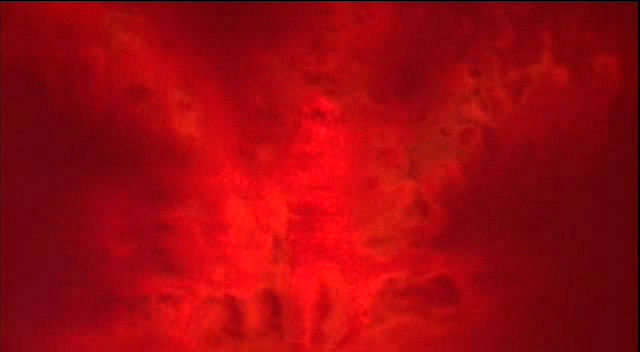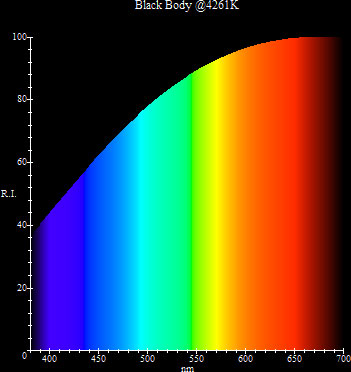
The vision of the Predator species (without vision enhanced technology) as shown in the movie "Predator" ([8]), with colors enhanced.
Let's see if we can do some detective work to determine the characteristics of the Predator home-world.

The Predator species without its vision-enhanced helmet sees the Earth plant-life as above[1][2]. Sampling the most luminous area of the above photograph with Photoshop, we find for example: RGB = 255,22,22. Running the Maple program in [1], we find that these values correspond roughly to λ=680nm.
Using the assumption that the Predator species has evolved to see through the dominant wavelength of their main star's spectrum, λ=680nm (similar to how human vision evolved to have maximum sensitivity around λ~555nm) and applying Wien's displacement law from [2], we find that the temperature of the main component in the star system of the Predator home-world, has a temperature T (in Kelvins) such that:
T*λ=2.898*106nm*K, hence for λ=680nm, T~4261°K
Using the Black Body spectral distribution again from [1], we can see the spectrum of the main stellar component:

After consulting with [3], the above means that the main star in the Predator's home-world is very likely a class K star. In the second Predator sequel, we can actually see that the Predator planet is illuminated by two stars:

Indeed, the brightest star looks like a K-type star. Using [1], we can see the overall color for a star of T~4261°K. Since (5000-3500)/10=150 and (4261-3500)/150~5, the approximate class is K5.


Using again [1] and sampling the second stellar component in the photo, we can see the color of the second star.


Maple gives a T~2100°K for the second component. Consulting with [3], this means the second component is a class M star. Since (3500-2000)/10=150 and (3500-2100)/150~9, the star's class is M9.
The stellar pair in the Predator's home-world is therefore approximately K5-M9. Consulting with [3] and [5], and discarding possible errors from the above calculations, the closest stars which fit the bill are Alpha Centauri B (K1) and Proxima Centauri (M5 red dwarf)(!).
Stars of class M show lines belonging to molecules and all neutral metals but hydrogen lines are usually absent. Titanium oxide can be strong in M stars, usually dominating by about M5. Vanadium oxide bands become present by late M ([3]).
Interestingly enough, such stars are immediate attractors for another dangerous entity, the Derelict ([6]), which spectroscopically scans entire star systems in search of sentient life around them. Scanning the K5-M9 combo from afar spectroscopically, would likely produce something of an average between K5 and M9, probably towards K7-K9, since the M type component looks like a red dwarf, with a limited luminosity (see picture above).
Indeed, the two species, the xenomorphs (which are creations of the Derelict) have met with the Predator species in the current science-fiction scenarios. So at least some of the astrophysical aspects of the Predator home-world are scientifically consistent with the dominant scenario.
Unfortunately there's a major discrepancy which ruins the nice analysis, above. In the last movie "Aliens vs. Predator: Requiem" ([7]), we see that one of the dying Predators aboard the space-ship which crashes on Earth after the emergence of the Predalien, initiates an S.O.S. signal when the movie shows the time to be 00:04:03 and the signal is intercepted by the Predator in the Predator home-planet when the movie shows the time to be 00:05:23. Assuming the movie keeps approximately the correct time, this means that the Predator home-world must be 1:20 light-minutes away from Earth.
1:20 light-minutes is ~ 300000(km/s)*80(s) = 24000000(km) = 24 million km's. The Earth orbits the sun at a distance of 150 million km's, so adding 150 + 24 million = 174 million km's. There's nothing at this distance from the sun. The next closest planet is Mars, at a distance of ~ 228 million km's.
When the Predator examines the S.O.S. message, the playback sequence shows what appears to be inter-stellar travel, and indeed, this species supposedly has such a capability. The problem is that regardless of the latter, any S.O.S. message is essentially electromagnetic radiation, so it travels at most with the speed of light, so this is a relativistic inconsistency[3], since a message to Alpha Centauri would need approximately 4.37 years to reach the Predator home-planet, if the Predator home-planet indeed resided there.